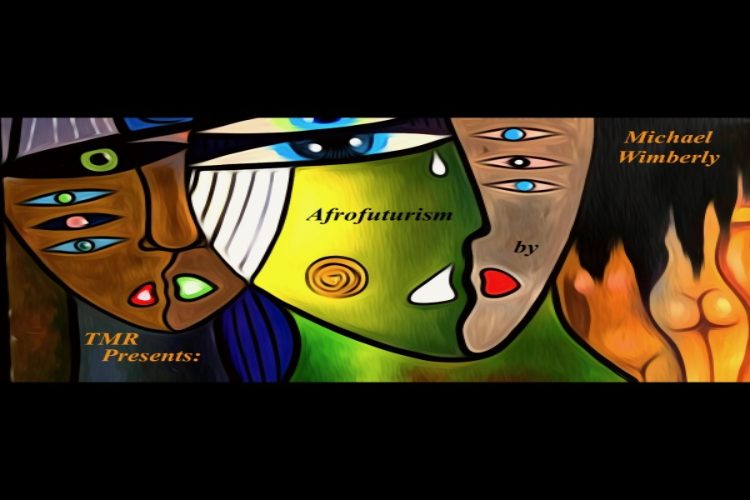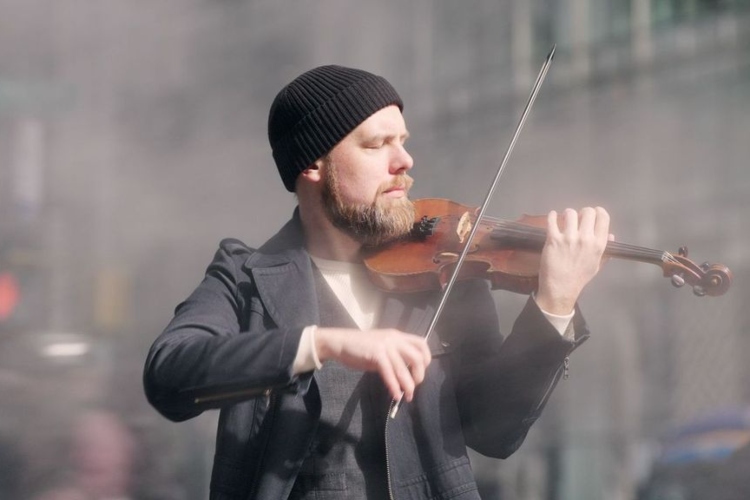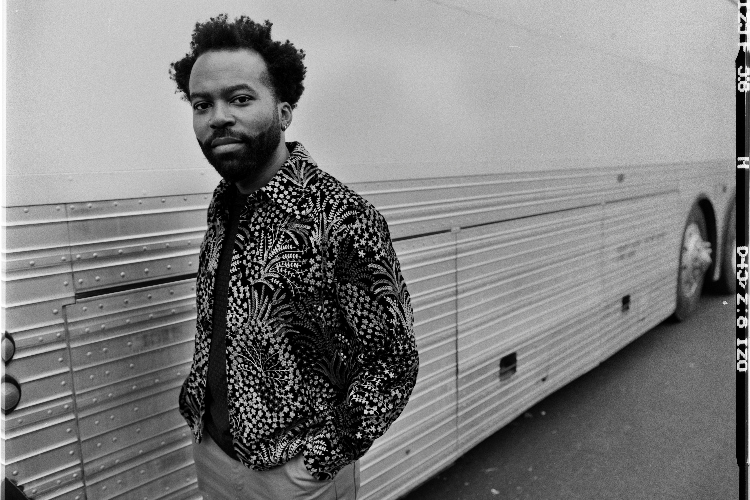Ancient to the Future: A Conversation with Michael Wimberly on ‘Afrofuturism’ (Part Two)
|
Getting your Trinity Audio player ready...
|
We continue our discussion with Michael Wimberly with an emphasis on the concept behind Afrofuturism (Temple Mountain Records, 2021), his influences, and his role as an educator.
PG: You had mentioned that the concept for Afrofuturism was at least partly based on your love of the “Ancient to the Future” concept. The title track sounds like it would fit in with 70s funk music like Parliament Funkadelic but also mentions Sun Ra. Obviously, both have been associated with the Afrofuturist concept, but it’s less common to hear them side by side in a single song.
MW: But to some extent, they do come from the same place. The idea of making Afrofuturism the focus of the album came from my teaching at Bennington College. I’ve been there for eight years. They tell you to teach what you know or what you like, so I ended up making a class on Sun Ra.
Sun Ra brought his music out into space to essentially neutralize racism. Out there, he could be who he wanted to be. He wasn’t judged by anyone. His music was healing and could take you to other galaxies. It allowed him to not be identified as a black man. Even though he didn’t depart from his cultural roots, he saw himself in the future. Of course, him saying he was from Saturn already put him apart from all of the other jazz guys.
The Afrocentric ideas of Parliament Funkadelic also focused on the future, creating a space entity and bringing music to various galaxies. And when you see Earth Wind and Fire or Sly and the Family Stone, their clothing designs and concepts come from Afrofuturist ideas. The Afrofuturist ideas jettison up to Erykah Badu. Even Beyoncé, Janelle Monáe, or Andre 3000 play with these ideas of creating a future world with science and technology. To have the old instruments of the kora, djembe, and balafon, at the core of modern music on Afrofuturism – creating a new voice and new direction- is also kind of “ancient to the future.”
PG: Speaking of your courses, you teach some really fascinating topics. One of the more interesting being “Zappa Meets P-Funk.”
MW: Yes, Man! I can’t believe you mentioned that. Are you kidding me? Just like I’ve been looking at your site’s reviews and you are covering some stuff that is blowing my mind.
I always wanted to play in Frank Zappa’s band. I play marimba, xylophone and stuff and love his music. And of course, there’s Parliament Funkadelic which has been very influential on me.
I discovered that Zappa and George Clinton had a lot in common. They were born within around seven months of each other. Both were innovative and had their own record labels. Both of their organizations became like universities for musicians. And both were influenced by doo-wop. A lot of parallels. And even now, though George Clinton is officially retired, within the last few years his band has been playing one song called “I’m the Slime” from an early 70s Zappa album. And it is funky, really funky.
But I have to add this to the whole “Zappa Meets P-Funk” thing. Some of my students who weren’t too familiar with Zappa’s lyrics really ripped him for the language, sexual overtones and concepts that seemed insulting. Some also take the same issue with P-Funk.
PG: As you had mentioned, throughout your career, you have been involved with theater, fashion, dance, and film. How do you feel like working with these different art forms has shaped your music or your creative process?
MW: I think having experience in theater, film, dance, and fashion definitely has shaped my direction musically. I have been able to build a repertoire of concepts that I can pull on to shape whatever project I am on because of these influences.
For example, I am currently working with some writers to develop a Broadway-style show on the history of hip hop. Although I don’t have a solidified background in hip hop, I have been very aware of its history, the rhythms that create it, and the feel. But digging further into hip hop itself is not my job. My job is to shape the music that came before hip hop– bebop, postbop, big band, ragtime, blues – and shape it to give a deeper appreciation and understanding of hip hop. It’s like making a score for a film but it’s live.
Theater, dance, film, and fashion have influenced me and I have learned about them. But I have consciously put ideas from them into my music, maybe less so overtly on Afrofuturism. But they are unconscious influences. From these disciplines, I’d say dance has influenced me the most. I’ve spent more time in the dance world and have been pushed to create everything from abstract soundscapes to grooves and ideas from all over the globe. It has really helped me shape who I am and where I am at this point.
PG: And you have also worked with an incredible list of other musicians over the years. Who do you feel like you have learned from the most?
MW: Oooh. Although I haven’t worked with him, I’d like to say Quincy Jones has been a big influence on me.
But out of all the people I have worked with, the biggest influence has been Charles Gayle. From working with him I’ve learned how to play silence. How to dialogue with an improviser. How to play behind someone who is soloing. How to put punctuations at the beginnings and endings of phrases. How to pray through music while you are playing it. And how to have the right intention when you are performing it. Those are ideas and concepts that you can keep working on throughout your life as you continue to develop as an artist. You can apply those things to any kind of music. If there is some way you can connect to your audience through the music you are playing and you can bring those elements of sincerity and purity in the moment, you are bringing something higher than yourself to the people and to the music.
Steve Coleman was also a big influence on me with his metrics and thinking in a symmetrical and asymmetrical way. How he meshed those grooves of Funkadelic and James Brown and all those people from the jazz idiom of Miles, Coltrane and even his main love, Charlie Parker. So, I’d say Charles Gayle and Steve Coleman were serious influences on me.
PG: To mention another great artist, you were the successor to Milford Graves’ professorship at Bennington College. What was that like?
MW: Milford has really big shoes to fill.
Bennington College hired both me and Susie Ibarra at the same time. Susie studied with Milford so there was a direct lineage there. I knew Milford because we had met several times and traveled to Portugal together once. Over time, Milford became a mentor figure to me. He is just incredibly daring and innovative and has a take no prisoners approach from my perspective.
Milford had advised the search committee to check me out. I passed their interview and whatever tests they had in mind and they decided to take me on. But they also made an exception to bring in Susie as well, or perhaps I was the exception. Either way, collaborating with Susie made building on what Milford created easier and it was beautiful to do so with such a like minded colleague.
Before the interview process, I didn’t know too much about Bennington other than Charles Gayle had worked there for a few years. I didn’t realize how many great musicians- improvisers in particular- came through Bennington as visiting lecturers, visiting artists, or performers. Bill Dixon brought Milford in, and I’m currently building on some of Bill Dixon’s courses now while in awe and inspired by what Milford and Bill created.
And now, sadly, Milford is not well as he’s suffering from a heart disease [editor’s note: Milford has amyloid cardiomyopathy, sometimes called “stiff heart syndrome”, a terminal and incurable disease]. His heart complications are a little ironic given he studies the heart and the hearts’ rhythms. However, Milford has such a zest and joy for life. It is hard to speak to him now; I think the last time I spoke to him was September. But to hear someone facing death and doing it so courageously is inspiring.
PG: Going back a little to categorizing music, some people would put Milford Graves or Bill Dixon into an avant-garde category and there’s been a long discussion about when artists are playing “in” or “out.” For instance, one remembers the shock many had in 1959 when encountering Ornette at the Five Spot. Do you feel like those strict lines between music that is “out” and that which is “in” have eased some over the years?
MW: Yes, I do believe those lines have been eased. I hope so! It still depends on how you come to a live performance or how you listen to a recording openly. I think we’re at a point where we can hear some really, you know, organized chaos from dense concepts musically and not be shocked.
But for those who can only follow a melody or must have a repetitive rhythm, hearing some really loose improv might scare them or just not be their cup of tea. It is something we have to bring young listeners to by helping them expand their hearing and their awareness so they are not just caught up in popular music.
I love those radio stations that just play a range of things. For one, I just love Columbia University’s WKCR 89.9 because you can hear almost anything there. I am a devotee to them because of their range. But every now and then I will venture out and listen to country, particularly older country songs because of the story, but also some of the more modern stuff. I am just searching for a story. I loved that album you reviewed from Michael Olatjua. Oh my god, that’s a great album man.
I turn on students to Ornette and lots of other improvisers. I have an improv class, but I only take you if I think you’re ready and you’re interested in that. The Sun Ra class isn’t something that requires you to play music but it has opened some students up through their visual arts and poetry and I am hoping those moments can help them be more embracing of new sounds and new directions. Interestingly, those sounds that Sun Ra and the Arkestra created are 60 years old now.
PG: One last question. As an educator, you are working with younger people – both musicians and non-musicians, as students. Normally younger people in particular tend to be looking for the “next thing.” Where do you think the future of music is? Do you have any thoughts on that?
MW: Man, I love that question. Whoo! I get so excited when a student comes to me and asks about a certain style of music – it could be anything, I don’t even have to know about it – but I am open enough to search and research the form to listening and directing them in their research on how we can cross-pollinate things. Paying homage to the ancient can sometimes create new ways of thinking about the future.
But one thing that comes up in school is the concept of appropriation, particularly the history of appropriation and when you are and are not engaging in appropriation. We try to bring that lesson periodically to our students to help them understand that you can be inspired by something and perform it, even if it is not in your cultural heritage and background. But if you are pretending to have invented it in order to try to make money off of it, then it is not appropriate. But the main thing I am seeing now is people who want to have a voice and be heard in whatever form they are excited about.The blend of folk, R&B, and hip hop seems to be a trend that is happening, at least in the colleges.
What my colleagues and I attempt to do is to advise students on taking classes that broaden their sonic palate. And so, with that we are hoping they experiment beyond what they would normally do. That giving them conceptual access to other ideas would influence them to be innovative and step outside of the box. And that is all you can do. It is a gamble and I am hoping the next generation of young music makers expand beyond 4/4 and that we see more popular music bringing in ideas from the Middle East, China, Africa, and other places. To me that is an exciting place to start.
Afrofuturism is being released in three parts. Part 1 is now available on Temple Mountain Records. Part 2 will be available on January 22, 2021, and Part 3 on February 19, 2021. More information on Michael Wimberly can be found on his website.



